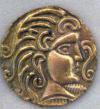Everyone Has Different 'Bad Spots' in Their Vision

The ability to distinguish objects in peripheral vision varies significantly between individuals, finds new research from University College London (UCL), Paris Descartes University and Dartmouth College, USA. For example, some people are better at spotting things above their centre of vision while others are better at spotting things off to the right.
The research, published in Proceedings of the National Academy of Sciences and funded by the Medical Research Council (MRC), the European Research Council and Dartmouth College, shows that on average we are worse at spotting objects in crowded environments when they are above or below eye level, although the extent to which this happens varies between individuals.The ability to distinguish objects in peripheral vision varies significantly between individuals, for example some people are better at spotting things above their centre of vision while others are better at spotting things off to the right
Credit: John Greenwood, UCL
The study involved 12 volunteers who took part in a series of perception tests over several years. The key experiment involved focusing on a point in the centre of the screen while images of clocks were shown in different parts of the visual field, either a clock alone or with two other clocks next to it. It is more difficult to tell the time on the central clock when the surrounding clocks are closer to it, as the scene is more visually ‘cluttered’. This is known as ‘visual crowding’.
Participants’ ability to successfully identify the central clock in a cluttered scene varied significantly, with different people better at spotting it in different positions. On average, most participants were weakest with their upper peripheral vision, followed by the lower peripheral vision. There was no significant difference between left and right on average, with some volunteers better on the left and others on the right.
Credit: John Greenwood, UCL
“Everyone has their own pattern of sensitivity, with islands of poor vision and other regions of good vision,” explains Dr Greenwood. “If you’re looking for your keys, then this profile will affect your ability to find them. For example, if your keys are on a table to the left of where you’re focusing, the presence of books and papers on the table may stop you spotting the keys. Someone with strong left-sided vision could spot the keys even if they’re right next to the book, whereas someone else might not notice the keys unless they’re a foot away from the book. There is substantial variation between different people.”
These ‘islands’ of poor vision were apparent across several tasks tested by the researchers, despite each relying on different processes in the brain. The implication is that these differences in peripheral vision could occur very early in the visual system, possibly beginning as early as the retina. It is unclear whether these differences are due to genetics or environment, but they are observed consistently over time.
“What is striking is the consistency of the pattern from the first levels of vision up to the highest levels, processing that involves very different areas of the brain,” explains senior author Professor Patrick Cavanagh (Dartmouth College). “We propose that these variations originate at the first levels of vision very early in our development where simple features like edges and colours are registered, and then are inherited by higher levels as the rest of the brain wires itself up to deal with the information being sent from the eyes. The higher levels deal with recognizing objects, faces, and actions, and directing our eyes toward areas of interest.”
Most people do not experience visual crowding in the centre of their vision, unlike the periphery, however in some conditions central vision is also affected. In amblyopia, also known as ‘lazy eye’, the brain does not interpret visual signals from one eye properly, leading to an increase in visual crowding. In dyslexia, some research has shown that people with the condition find it easier to read words when the letter spacing is increased to reduce visual crowding. Similarly, visual crowding effects may be one of the early symptoms of Posterior Cortical Atrophy, a form of dementia that predominantly affects vision. Crowding is also a factor in macular degeneration, the most common form of blindness, where the centre of the eye is affected first and so patients must rely on their peripheral vision to see.
“Our new paper helps us to better understand the mechanisms that cause visual crowding and where these occur in the visual system,” says Professor Cavanagh. “In the long term, we hope that this will help with the development of better treatment strategies for a wide range of conditions that limits the usefulness of vision for millions of people worldwide.”
Source:
Anyone can join.
Anyone can contribute.
Anyone can become informed about their world.
"United We Stand" Click Here To Create Your Personal Citizen Journalist Account Today, Be Sure To Invite Your Friends.
Before It’s News® is a community of individuals who report on what’s going on around them, from all around the world. Anyone can join. Anyone can contribute. Anyone can become informed about their world. "United We Stand" Click Here To Create Your Personal Citizen Journalist Account Today, Be Sure To Invite Your Friends.
LION'S MANE PRODUCT
Try Our Lion’s Mane WHOLE MIND Nootropic Blend 60 Capsules
Mushrooms are having a moment. One fabulous fungus in particular, lion’s mane, may help improve memory, depression and anxiety symptoms. They are also an excellent source of nutrients that show promise as a therapy for dementia, and other neurodegenerative diseases. If you’re living with anxiety or depression, you may be curious about all the therapy options out there — including the natural ones.Our Lion’s Mane WHOLE MIND Nootropic Blend has been formulated to utilize the potency of Lion’s mane but also include the benefits of four other Highly Beneficial Mushrooms. Synergistically, they work together to Build your health through improving cognitive function and immunity regardless of your age. Our Nootropic not only improves your Cognitive Function and Activates your Immune System, but it benefits growth of Essential Gut Flora, further enhancing your Vitality.
Our Formula includes: Lion’s Mane Mushrooms which Increase Brain Power through nerve growth, lessen anxiety, reduce depression, and improve concentration. Its an excellent adaptogen, promotes sleep and improves immunity. Shiitake Mushrooms which Fight cancer cells and infectious disease, boost the immune system, promotes brain function, and serves as a source of B vitamins. Maitake Mushrooms which regulate blood sugar levels of diabetics, reduce hypertension and boosts the immune system. Reishi Mushrooms which Fight inflammation, liver disease, fatigue, tumor growth and cancer. They Improve skin disorders and soothes digestive problems, stomach ulcers and leaky gut syndrome. Chaga Mushrooms which have anti-aging effects, boost immune function, improve stamina and athletic performance, even act as a natural aphrodisiac, fighting diabetes and improving liver function. Try Our Lion’s Mane WHOLE MIND Nootropic Blend 60 Capsules Today. Be 100% Satisfied or Receive a Full Money Back Guarantee. Order Yours Today by Following This Link.






